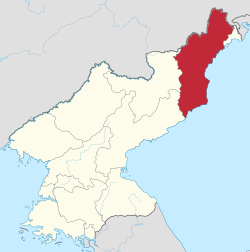North Hamgyong Province
North Hamgyong Province (Hamgyŏngbukdo Korean pronunciation: [ham.ɡjʌŋ.buk̚.t͈o]) is the northernmost province of North Korea. The province was formed in 1896 from the northern half of the former Hamgyong Province.
North Hamgyong Province 함경북도 | |
|---|---|
| Korean transcription(s) | |
| • Chosŏn'gŭl | 함경북도 |
| • Hancha | 咸鏡北道 |
| • McCune‑Reischauer | Hamgyŏngbuk-to |
| • Revised Romanization | Hamgyeongbuk-do |
 | |
| Country | North Korea |
| Region | Kwanbuk |
| Capital | Chongjin |
| Subdivisions | 4 cities; 12 counties |
| Government | |
| • Party Committee Chairman | Ri Hi-yong[1] (WPK) |
| • People's Committee Chairman | Ri Sang-kwan[1] |
| Area | |
| • Total | 20,345 km2 (7,855 sq mi) |
| Population (2008)[2] | |
| • Total | 2,327,362 |
| • Density | 110/km2 (300/sq mi) |
| Time zone | UTC+9 (Pyongyang Time) |
| Dialect | Hamgyong |
Geography
The province is bordered by China (Jilin) on the north, South Hamgyong on the southwest, and Ryanggang on the west. On the east is the Sea of Japan. The province is home to the Musudan-ri rocket launching site, and the Hoeryong concentration camp. In 2004 Rason was reabsorbed back into the province, and since 2010 Rason is again a Directly Governed City.
Most North Korean defectors that settle in South Korea come from North Hamgyong. Because of this, the province and its people are among the most well-researched topics of North Korea. Knowledge concerning the province is often erroneously generalized to concern the whole country, or ignored for being about "a backward province of a backward country ... unlikely to become popular reading: North Hamgyong is, after all, not only a very grim, but also a very boring place."[3]
Administrative divisions
North Hamgyong is divided into three cities (si) and 12 counties (kun).[4] These are further divided into villages (ri) in rural areas and dong (neighborhoods) in cities. Some cities are also divided into wards known as "kuyŏk", which are administered just below the city level.
Counties
|
|
|
|
See also
- Punggye-ri Nuclear Test Site
- 2006 North Korean nuclear test
- Administrative divisions of North Korea
- List of Korea-related topics
References
- "Organizational Chart of North Korean Leadership" (PDF). Seoul: Political and Military Analysis Division, Intelligence and Analysis Bureau; Ministry of Unification. January 2018. Retrieved 17 October 2018.
- https://unstats.un.org/unsd/demographic/sources/census/wphc/North_Korea/Final%20national%20census%20report.pdf
- Tertitskiy, Fyodor (8 July 2016). "The flaws and biases in North Korean studies". NK News. Retrieved 27 July 2016.
- http://www.cybernk.net/infoText/InfoAdminstList.aspx?mc=AD0101&ac=A09